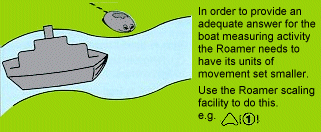
|
Feedback Form

ROAMER, TURTLE AND MEASUREMENT 2

In the last issue, key ideas of measurement were introduced. In this issue, the notion of accuracy is explored in more detail.
The river measuring game illustrated the importance of the practical context in deciding the measurement that was actually to be made. If we modify the problem, some other ideas become apparent. Instead of measuring the river so that we can 'build' a bridge across it, let's measure it in order to determine the size of the widest boat that could navigate the river without getting stuck!

For the bridge activity, answers within one or two Roamer units (body length of Roamer) were accurate enough. For the boat problem a more precise answer is required. This provides an indication that the nature of the measuring device has a significant impact on the measurement itself.
The development of the metre as a unit of measurement reveals some interesting points. In 1791, the first definition of the metre was as one ten millionth of the length of the quadrant of the earth's meridian through Paris. As the accuracy of measurement improved, it became apparent that what everyone was calling a metre no longer met the definition, so the definition was changed. In 1927, the standard metre was defined as the distance between two marks on a bar of platinum-iridium supported on two knife edges a set distance apart and kept in a sealed box at a specific temperature. From this, all other metres were measured.
Today the metre is defined as the distance travelled by light in a vacuum during a time interval of 1/299,792,458 seconds. It is highly unlikely that the marks on your tape measure match that definition with any great precision!
We can see from this that the environment in which we are measuring is also important: the temperature was significant when the bar was used as the measure and free space is important to the definition that uses the speed of light. Scientists are familiar with the concept of errors in measurement. They constantly endeavour to reduce errors to a minimum and sometimes need to adjust their measurements to account for the effects of known differences in environment.
These aspects of measurement can provide pupils with some interesting science projects for both Roamer and Turtle.
- Explore the way Turtle or Roamer can operate as a measuring device.
- Try measuring with the Roamer/Turtle moving on different surfaces: carpets, wood floors, hard flat desk tops, etc.
- Is there a difference in measurement made by the Roamer/Turtle going in a forward or a backward direction?
- Is there a difference in the measurements made by Roamer/Turtle moving up a slope or down a slope?
- Is there a difference in the distance measured when the Roamer/Turtle uses one movement or several movements?
Can the pupils find reasons for the differences? Can they suggest ways of allowing for errors?
| Back |
|---|